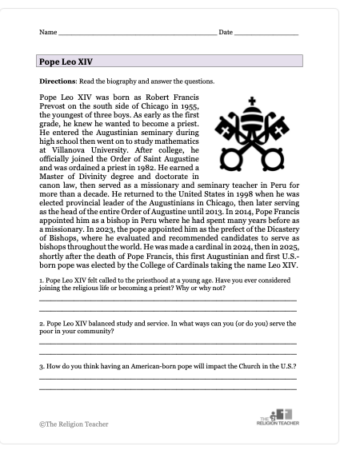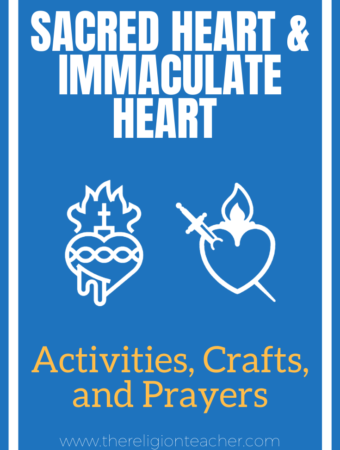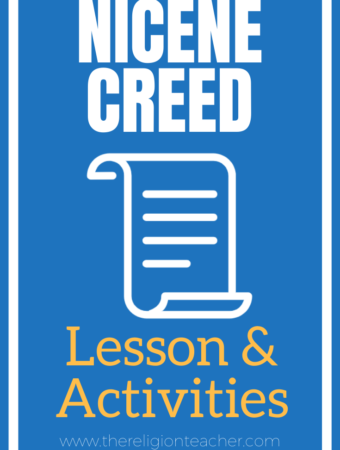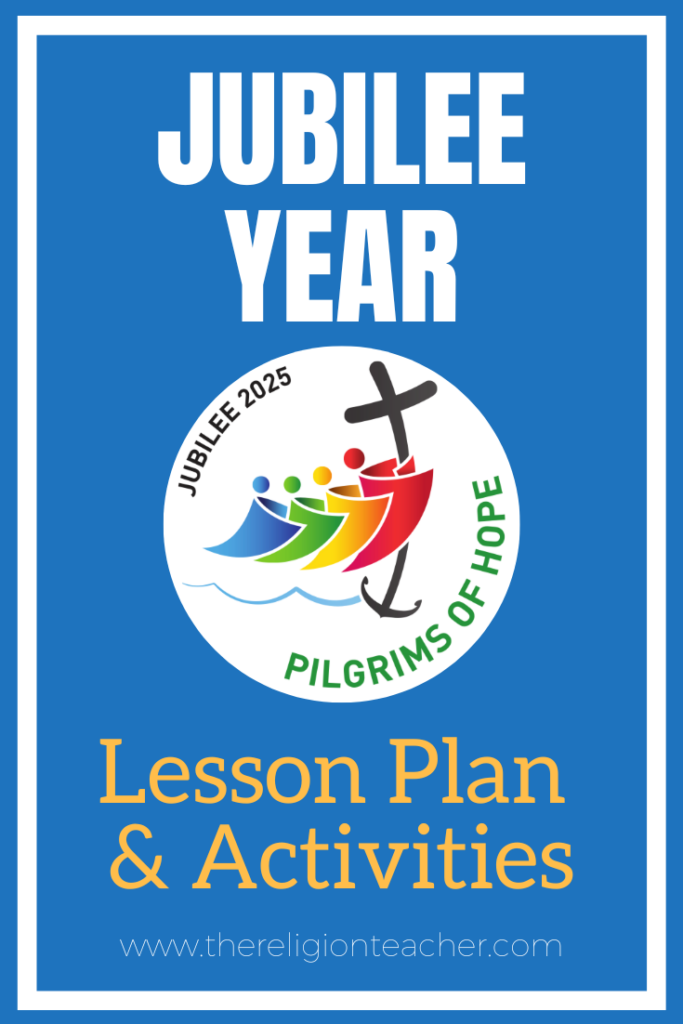
Pope Francis declared 2025 to be a Jubilee Year in the Catholic Church. This lesson plan provides some ideas for teaching about this Holy Year and the ways your students can participate without making an actual pilgrimage to Rome.
Jubilee Year Lesson Objectives
- Students will be able to (SWBAT) explain what a Jubilee Year is in the Catholic Church.
- SWBAT list ways they can participate in the 2025 Jubilee Year.
- Students will feel excited to participate in one of the spiritual opportunities during this year.
Jubilee Year Lesson Activities
Lesson Hook
It may seem like an odd question, but ask students to describe some of their favorite doors.
These doors might be the doorways to their homes, their rooms, their schools, their churches, or even gates and doorways to places like stadiums or office buildings.
Next show them images of the four holy doors of the four major basilicas in Rome. (You can find images of these doors here.)
Explain that we are celebrating a Jubilee Year in 2025 and these doors are cemented shut at all times other than the Jubilee Years that occur every 25 years. The Pope has invited pilgrims to travel to Rome to pray and enter through these doors to celebrate the Jubilee.
Introducing the Jubilee: Jubilee Year 2025 Worksheet
Invite students to read about the Jubilee Year with this short summary:
Every twenty-five years, the Catholic Church celebrates a sacred Jubilee to encourage special prayers and sacred pilgrimages. From Christmas Eve in 2024 to the Epiphany on January 6, 2026, Pope Francis invites us to be “Pilgrims of Hope.” Catholics are encouraged to embark on a holy journey, known as a pilgrimage, to Rome or other sacred sites closer to home. The holy doors of the four major basilicas are normally cemented shut, but during Jubilee Years they are opened! Pilgrims will enter these sacred buildings through the holy doors as a symbol of salvation through Jesus Christ, who once called himself “the gate” through which we are saved (Jn 10:9).
But you don’t have to go to Rome to celebrate the Jubilee! Pilgrims can gain a special grace called an indulgence either for themselves or the souls in purgatory by visiting the four major basilicas, but also through visits to other sacred sites designated by local bishops. Additionally, we can obtain an indulgence by practicing works of mercy, such as giving to the poor or visiting the sick, or by performing acts of penance like fasting from food, devices, or entertaining media. This 2025 Jubilee is a special opportunity to experience God’s love as “pilgrims of hope.”
Jubilee Year Questions
Lead them in a discussion with these questions:
1. What are some ways you can participate in the Jubilee?
2. Why do you think “hope” is a good message to share in the world today?
3. What are things you can give up as an act of penance during the Jubilee year?
You can also download the one-page worksheet for the Jubilee Year here:
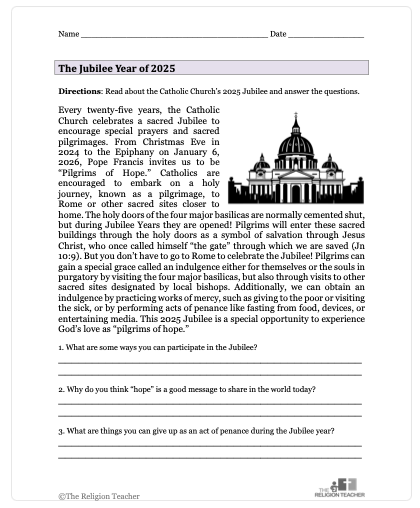
Understanding the Theme: Pilgrims of Hope
“During the Holy Year, we are called to be tangible signs of hope for those of our brothers and sisters who experience hardships of any kind.”
—Pope Francis, Spes Non Confundit, 10
The logo for the Jubilee Year features four stylized people (symbolizing the people coming from the four corners of the globe) reaching for the cross, which takes the shape of the classic symbol of hope: the anchor.

Share this video with students to understand the symbolism of the anchor and hope:
“The image of the anchor is eloquent; it helps us to recognize the stability and security that is ours amid the troubled waters of this life, provided we entrust ourselves to the Lord Jesus. The storms that buffet us will never prevail, for we are firmly anchored in the hope born of grace, which enables us to live in Christ and to overcome sin, fear and death.”
—Pope Francis, Spes Non Confundit, 25
Understanding Plenary Indulgences
To seek an indulgence is to seek the experience of God’s infinite mercy. As Pope Francis reminds us in his papal bull establishing the Jubilee: “Indeed, the indulgence is a way of discovering the unlimited nature of God’s mercy. Not by chance, for the ancients, the terms ‘mercy’ and ‘indulgence’ were interchangeable, as expressions of the fullness of God’s forgiveness, which knows no bounds.” (Spes Non Confundit, 23).
During the Jubilee Year, all faithful Catholics “who, during the Holy Year, purified through the sacrament of penance and refreshed by Holy Communion, pray for the intentions of the Supreme Pontiff, will be able to obtain from the treasury of the Church a plenary indulgence” can receive an indulgence in the following ways:
- Pilgrimage to Rome, the Holy Land, or local cathedrals and sacred sites designated by the local bishop
- Pious visits to sacred places designated as Jubilee sites
- Works of mercy
- Acts of penance
(Read the full Vatican decree about Plenary Indulgences during the Jubilee Year here.)
Share this video to help students understand what an indulgence is and why we should hope to obtain them during the Jubilee Year:
Meditation: Jubilee Year Pilgrimage and Practices
Put simply, students can participate in the Jubilee Year in the following ways:
- Pilgrimage
- Works of Mercy
- Acts of Penance
This may take some time, but encourage families to make a pilgrimage to one of the local Jubilee sites in your diocese or organize a pilgrimage field trip yourself.
Something you can do each day or each week, is challenge students to pick one work of mercy or one act of penance to practice. They can do so seeking a plenary indulgence or just as a way to participate in the sacred Jubilee.
Spend some time in class inviting students to select a work of mercy or act of penance
Here are some ideas to share:
Works of Mercy Ideas
The corporal works of mercy are:
- Feed the Hungry
- Give Drink to the Thirsty
- Clothe the Naked
- Shelter the Homeless
- Visit the Sick
- Visit the Imprisoned
- Bury the Dead
The spiritual works of mercy are:
- Counsel the Doubtful
- Instruct the Ignorant
- Admonish Sinners
- Comfort the Sorrowful
- Forgive Offenses
- Bear Wrongs Patiently
- Pray for the Living and the Dead
Acts of Penance Ideas
Here are some suggestions from the Jubilee decree on indulgences:
“In particular the penitential nature of Friday can be rediscovered through abstaining, in a spirit of penance, at least for one day of the week from futile distractions (real but also virtual distractions, for example, the use of the media and/or social networks), from superfluous consumption (for example by fasting or practising abstinence according to the general norms of the Church and the indications of the Bishops), as well as by donating a proportionate sum of money to the poor; by supporting works of a religious or social nature, especially in support of the defence and protection of life in all its phases, but also by supporting the quality of life of abandoned children, young people in difficulty, the needy or lonely elderly people, or migrants from various countries “who leave their homelands behind in search of a better life for themselves and for their families” (Spes non confundit, 13); it can also be obtained by dedicating a reasonable portion of one’s free time to voluntary activities that are of service to the community or to other similar forms of personal commitment.”
So, to summarize students can abstain (especially on Fridays) from:
- mobile devices
- distractions such as social media
- meat
- snacks
- donating money to the poor
- supporting work of non-profits and charities (especially those dedicated to children, elderly, and migrants)
- volunteering time in community service
Have students create a poster to put on the wall during the Jubilee Year as a reminder of these and other ideas for works of mercy and penance. Students can then reference that poster throughout the Jubilee Year to select daily ways to participate.
The Jubilee Prayer 2025
Close the lesson using the official Jubilee Prayer from Pope Francis:
Father in heaven,
may the faith you have given us
in your son, Jesus Christ, our brother,
and the flame of charity enkindled
in our hearts by the Holy Spirit,
reawaken in us the blessed hope
for the coming of your Kingdom.
May your grace transform us
into tireless cultivators of the seeds of the Gospel.
May those seeds transform from within both humanity and the whole cosmos
in the sure expectation
of a new heaven and a new earth,
when, with the powers of Evil vanquished,
your glory will shine eternally.
May the grace of the Jubilee
reawaken in us, Pilgrims of Hope,
a yearning for the treasures of heaven.
May that same grace spread
the joy and peace of our Redeemer
throughout the earth.
To you our God, eternally blessed,
be glory and praise for ever.
Amen
Jubilee Year Activities
The lesson plan above is meant to help you introduce the Jubilee Year to your students. Here is a list of activity ideas and prayers you can use to engage your students in the Jubilee throughout the year:
- Open with the Jubilee Prayer – Open each class with the Jubilee Prayer throughout the year and pick out a phrase after you recite the prayer to challenge students to remember and live out in a special way. Phrases of the day might be “reawaken in us the blessed hope for the coming of your Kingdom” or “tireless cultivators of the seeds of the Gospel” or “may that same grace spread to the joy and peace of our Redeemer throughout the earth.”
- Organize a Local Pilgrimage – Schedule a class pilgrimage to your diocese’s cathedral or other sacred site designated by the bishop as the place to celebrate the Jubilee Year.
- Decorate Your Own Holy Door – Decorate the door of your classroom with sacred images created by your students. Ask them to prayerfully enter the classroom throughout the year in solidarity with the pilgrims who are traveling to Rome.
- Practice Works of Mercy – Teach the students about the works of mercy (lesson plan here) and then select one work of mercy per week or per day to practice as a class. Remind the students that these works of mercy can be ways in which they can obtain an indulgence (after following the ordinary dispensation requirements).
- Follow Jubilee Events – Specific groups are invited to make pilgrimages at specific times throughout the year. The Jubilee of Youth, for example, is scheduled for the end of July/beginning of August. Look at the official websites’s online calendar and feature virtually some of the events in class.
